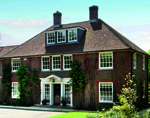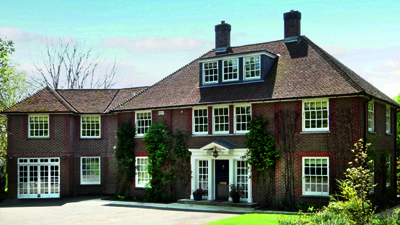London commuters look to The Chilterns
The Chilterns are offering increasing value for money to buyers coming out of London, where prices have rocketed


The Chilterns stretch for 46 miles from Hertfordshire to Oxfordshire through Bedfordshire, Berkshire, and Buckinghamshire and Oxfordshire, but the Chilterns country-house market tends to focus mainly in three directions: the Hambleden Valley area around Henley-on-Thames in south Oxfordshire, which appeals to foreign, aspirational and celebrity buyers; the area around Beaconsfield, Buckinghamshire, where excellent train services are a magnet for London commuters; and the area around Wallingford, Oxfordshire, where ease of access to schools in Abingdon and Oxford is a major attraction.
Frank Speir, of buying agent Prime Purchase, acknowledges the region's perennial appeal, but doesn't pull his punches when it comes to assessing the immediate prospects for the country market in the Chilterns. ‘With few signs as yet of a massive increase in supply and buyers still in no great hurry to make decisions (hardly surprising, given the recently increased levels of Stamp Duty), I don't foresee any significant increase in the number of transactions taking place at the upper end of the market this year. These days, buyers know the value of everything, and even the perfect house won't sell at the wrong price. With relatively few houses to choose from, selling agents have a greater responsibility than ever to ensure that their properties are priced accurately from the outset, otherwise the head of steam built up during the initial launch will swiftly evaporate.'
Nothing spooks buyers or vendors more than seeing good country houses hanging about on the market, being switched from one agent to another or being periodically re-launched at progressively lower prices. There may be nothing at all the matter with the house, apart from the price, but neither buyers nor sellers of expensive houses like to be seen getting their sums wrong. In the end, the distractions and uncertainties of 2012 caused the top end of the country-house market to more or less disappear underground, and many of the most important sales that took place in the Chilterns last year were conducted behind closed doors-and Draconian confidentiality clauses.

Culzean House, Savills, £2m
* Subscribe to Country Life and save
But that was then, and this is now. Fortunately, the dawn of a new year appears to have brought fresh energy and transparency to the market in the Chilterns. For Andrew Cronan of Savills in Beaconsfield, the January blues were dispelled by the exchange of contracts on imposing Orchard Poyle at Burnham, Buckinghamshire, at a guide price of £3.65 million. First built in the 18th century and substantially remodelled in the early 1900s, the handsome, eight bedroom house stands in 16 acres of gardens and parkland in leafy countryside close to the Cliveden National Trust estate. More encouraging, perhaps, was the fact that it was bought by a family moving out from London-a species conspicuous by its rarity here in recent years. Mr Cronan expects to see many more families moving out of the capital and buying in the Chilterns due to its excellent rail links and unique choice of high-achieving schools, both independent and State-funded.
‘The growth of property values in London in recent years means that people selling in London can now get appreciably more for their money in the Chilterns than they would've done three or four years ago,' he explains. Mr Cronan lifts the veil on one of this season's newcomers, the appealing neo-Georgian Culzean House at Bradenham, Buckinghamshire, a picturesque village set in sloping downland between High Wycombe and Princes Risborough, and owned by the National Trust since 1956. Built as a rectory in 1961 and sold by the Church soon afterwards, it will shortly be launched on the market through Savills (01494 731952) at a guide price of £2m.
Sign up for the Country Life Newsletter
Exquisite houses, the beauty of Nature, and how to get the most from your life, straight to your inbox.
The present owners have lived there for more than 10 years, during which time they have renovated the kitchen and bathrooms, decorated throughout and made numerous practical improvements, including the installation of air-conditioning, a bore hole, an emergency generator and an automated sprinkler system in the garden. Culzean House has three reception rooms, a detached one-bedroom annexe, a heated swimming pool and 1. 5 acres of garden.
‘Nothing ordinary ever happened here, nor could it' is the motto of the celebrated Cliveden Hotel, but the words could just as well apply to developer Robert Cantle's ambitious redevelopment of the model farm built by Lord Astor in the early 1900s at Cliveden Deep, a beguiling stretch of the Thames that runs beneath the wooded slopes of Cliveden House, between Cookham and Maidenhead, Berkshire. Having masterminded a string of ambitious development projects in north Surrey and elsewhere, Mr Cantle, who lives in Cookham Dean, had no hesitation in buying the entire model-farm complex when it came on the market three years ago. ‘Recession, what recession?' he might have asked as he prepares to launch The Astor, the last and most spectacular of his model-farm conversions, on the market at a guide price of £4.95m through Hamptons (01494 672969) and Knight Frank (020-7629 8171)-having, of course, already sold the previous six.
The extraordinary building, listed Grade II, which combines state-of-the-art technology with the tactile charm of wood and glass, boasts a dramatic central atrium with a galleried music/sitting roo overlooking the river, a vast central living area, his and her master suites, five luxury guest suites, a cinema, a wine cellar and a health and leisure unit. Hidden behind high walls, The Astor is approached by a grand, carriage-style driveway that sweeps around a central island, flanked by two 16th century barns. A rear garden gives access to a private treelined footpath leading to the Thames, where farm produce was loaded onto barges for delivery to Cliveden House on the opposite bank.
* Follow Country Life property on Twitter
Country Life is unlike any other magazine: the only glossy weekly on the newsstand and the only magazine that has been guest-edited by HRH The King not once, but twice. It is a celebration of modern rural life and all its diverse joys and pleasures — that was first published in Queen Victoria's Diamond Jubilee year. Our eclectic mixture of witty and informative content — from the most up-to-date property news and commentary and a coveted glimpse inside some of the UK's best houses and gardens, to gardening, the arts and interior design, written by experts in their field — still cannot be found in print or online, anywhere else.
-
 About time: The fastest and slowest moving housing markets revealed
About time: The fastest and slowest moving housing markets revealedNew research by Zoopla has shown where it's easy to sell and where it will take quite a while to find a buyer.
By Annabel Dixon Published
-
 Betty is the first dog to scale all of Scotland’s hundreds of mountains and hills
Betty is the first dog to scale all of Scotland’s hundreds of mountains and hillsFewer than 100 people have ever completed Betty's ‘full house’ of Scottish summits — and she was fuelled by more than 800 hard boiled eggs.
By Annunciata Elwes Published
